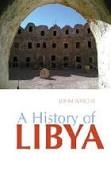|
Reviewed by Wyndham E. Whynot, Ph.D., Associate Professor, Department of History, Livingstone College Generally, when people think of Libya, the typical items they may recall are the country’s involvement with, or support of, terrorism during the latter 20th and early 21st centuries, and/or some familiarity with Moammar Gadafi, the former leader. John Wright, a former BBC political commentator on Libya and author of several books on the country, initially wrote a 1969 general history titled Libya. Wright’s most current work, is actually a “…lightly edited, corrected, and amended …” (vii) updated version of his 1969 work. Despite essentially being a republished work, it is still an excellent survey of Libyan history. The first part of the book is a series of chapters that provide a quick, but only somewhat solid, examination of various civilizations, such as Phoenicia, Greece, Rome, and the Arab peoples, who have settled or exploited Libya. Each colonizing civilization has followed a similar pattern of coastal settlements with some limited attempts to control the interior. Wright reminds us that Libya’s harsh environment, as well as the active opposition of indigenous groups such as the Berbers and Tuaregs made it difficult for the various powers to adequately control a unified Libya. Opposition to foreign rule is a theme that Wright weaves throughout the majority of his work. The shift to rule by Ottoman and modern European powers, as well as the history of an independent Libya, are dealt with in the latter half of the book. Ottoman control gradually grew from a firm rule over the area to a more liberal rule, under which Libya was generally left alone as long as the nation paid its taxes and basically swore allegiance to the Ottoman Empire. It was during that latter part of Ottoman rule when the Sanussi Brotherhood, a Muslim political-religious order, acquired support from segments of Libyan society. Wright deals with the history of this order and demonstrates its impact on Libya between its foundation in 1837 through the fall of King Idris I in 1969. Wright shows how this group formed a basis upon which the disparate groups of Tripolitania and Cyrenaica, as well as the Fezzan, could cooperate in their fight for an independent country. Wright provides his reader with background on the difficulties Italy faced and the methods used to conquer the region. Despite Italy’s temporary success, Wright indicates that Libya cost the nation more than it brought in, as enormous expenditures were made to construct an infrastructure for both Italian migrants and the native population. Even so, the economic prospects, primarily in agriculture, were a long way off. World War II resulted in eventual Libyan independence in 1951; but despite a constitutional monarchy and a parliamentary system, Libya still faced significant problems, one that the discovery of petroleum seemed capable of fixing. Idris I failed to provide adequate leadership, leading to a 1969 coup d’etat lead by Gadafi. Wright’s final chapter focuses on Gadafi’s rule, an era of seeming promise, yet one that failed to meet the expectations. Gadafi is shown as both a charismatic and popular ruler both inside and outside of Libya, yet also as one whose government makes political decisions which are disastrous for his people. Despite his willingness to make reforms, the question of whether he would make the proper choices remains. In his final statement, Wright notes, “Libya still had the human and mineral resources to make a better future for itself.” (p. 229) Since the book’s publication, Libya has removed Gadafi from power; yet the same question remains: will the Libyan people be able to take advantage of the opportunity they now have or will they fall back on the policies of the two proceeding governments? Wright’s book is focused more towards providing non-academics an opportunity to learn Libya’s history. Wright’s work is well-researched, and although he depends heavily upon secondary sources, he also utilizes a variety of primary sources, including various United Nations reports, as well as official British and Italian documents and reports. Despite the extensive bibliography, the author’s inconsistent use of citations throughout the text – providing them in some cases, but failing to utilize them in others – is, in the reviewer’s opinion, the book’s biggest flaw. Even so, Wright has created a well-written and relatively easy to understand history of Libya that is immediately accessible to the general public and to academics. Arguably, this work could benefit from an expanded focus on various chapters, such as the Gadafi era, yet Wright’s goal was to provide a general history of Libya, a task which he more than adequately accomplishes. Individuals interested in learning about Libya, imperialism, and colonialism in North Africa will find this book useful; it is definitely worth reading. |


 History of Libya
History of Libya